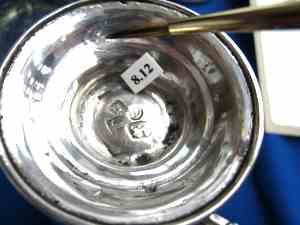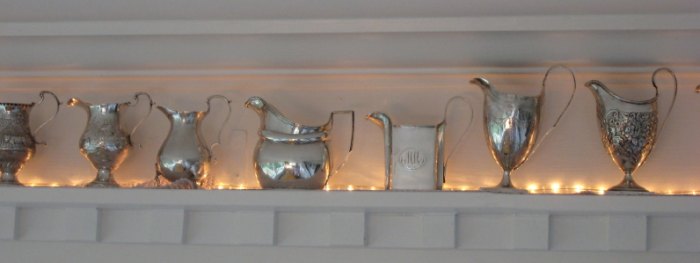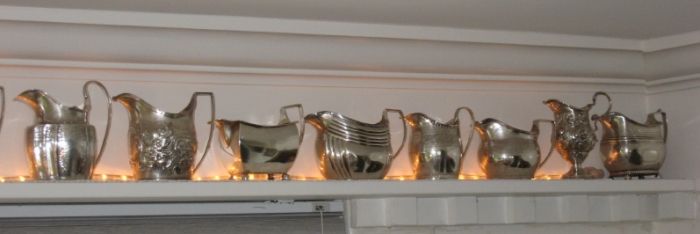by Richard
Hyman
(click on photos to enlarge image)
CARE AND CONSERVATION OF SILVER FOR PRIVATE COLLECTIONS,
A WORK IN PROGRESS
I collect Georgian silver but, lacking the space for
vitrines I display my hollowware on open shelves where they
rapidly tarnish. I had either to stop collecting hollowware,
accept disfigurement, commit to continued laborious and possibly
deleterious cleaning, or find reliable tarnish protection. I
decided on tarnish protection. I thought it would be easy; it
wasn’t.
I started with the most respected silver repair shop in Seattle
where I live. They would, for an undisclosed price, clean and
coat pieces with an undisclosed coating. I would have to leave
items with them, receive an estimate, and trust their work. The
option would involve an hour plus round trip drop off and pick
up each time for uncertain and costly results, possibly equal to
what I’d paid for the pieces, for work I thought I could do
myself.
I could find no texts for guidance. I searched the web, asked
manufacturers, dealers, and other collectors, with mixed
results. Some manufacturers were helpful, others secretive or
uncommunicative. I was surprised by the sparse, too often conflicting, information.
I identified the V & A and UK Conservation Register online
articles, which I append, as being most useful. They contain
basic, and possibly serious, disagreements such as the use of
Silver-Dip. The UK Conservation Register recommends it, whereas
V&A does and does not.
Not only conflicting, but incomplete.
I have spoken and corresponded with conservators at major
institutions for help. Conservators are cautious: they work with
valuable, often irreplaceable objects and are trained to avoid
damage. A responsible conservator is careful in providing
opinions. Their standards are perforce higher than most private
collectors. They are aware they might be misunderstood,
misspeak, or mislead, and might be liable to legal issues. I
therefore maintain my sources anonymity.
I offer the following procedures based upon my research and
practice. The best I can say is, it suits my purposes.
|
|
|
The Georgian cream jug shelf. The display is
by date, starting with the earliest on the left
|
CLEANING SILVER
While there are many silver cleaners on the market, the V &
A uses Goddard’s Long Shine Silver Foam, available in two sizes
direct from the manufacturer. It removes tarnish effectively
without apparent damage albeit sometimes with considerable
effort.
Where the tarnish is especially stubborn I use a small felt
buffing wheel in a hand held Dremel tool operating at minimal
speed, moving the disc to avoid swirl marks. I cautiously use
red or white rouge if I wish to buff out unsightly areas, but
take care not to obliterate patina. I have used a stainless
steel dental scraper to remove stubbornly embedded dirt.
Cleaning can be a tedious process especially if the piece is
heavily tarnished. I use differing lights but stain can be very
difficult to detect on the reflective surface.
After cleaning I wash the silver repeatedly with warm tap water
either with a mild soap or non phosphate detergent, wiping it
with a soft cotton cloth to ensure no trapped Foam remains. The
V&A uses deionized water but I have decided not to be that
scrupulous.
Some conservators recommend Goddard’s Silver Dip, a blue liquid
that miraculously removes tarnish without effort. It contains
thiourea which I long ago used to clean daguerreotypes. Well and
good, except that most recently the V & A website advises never
to use it or any other chemical cleaner. They state Silver-Dip
can leave a white surface, remove the patina, and make the
surface hyper-active accelerating future tarnish, which I
believe was my experience using it.
I have tried Hagerty’s silver polishing cloth, another product
recommended by experts. I found it was not effective in
preventing tarnish. The UK Conservation Register cautions
against using it for antique silver and I no longer use it.
GLOVES
I wear white cotton gloves to handle silver except when I’m
washing it. I figure the soapy water will remove oils on my
hands.
|
|
|
Detail of the Georgian cream jug shelf.
|

MARKING SILVER
One institution employs alkyd paint for applying
acquisition numbers. I use black Winsor Newton Griffin
Alkyd paint with a 0 or finer hair brush. At first I
used a thin layer of paint but have found a more
substantial layer reads and lasts better. Despite having
lettered professionally I find painting on a reflective,
often curved, surface difficult and the results usually
not satisfactory. Solvents, such as acetone, will remove
alkyds from silver.
Another museum practice is the use of a permanent
archival pen directly on the silver or on a removable
dot of acrylic paint. I have not used this and suspect
coating solvents might dissolve it.
A more recent alternative I intend to adopt is to
computer print the identification using thin acid-free
paper. Paint a dab of acryloid on the piece, adhere the
number on it, and top coat it with another dab of
acryloid, or when you coat the piece.
on the right: affixing printed identification
labels to silver with Soluvar
|
COATING
Coating silver is controversial; some institutions do it,
others are shocked. But institutions have sealed cases; I don’t.
There are complaints about lacquer peeling, ugly discoloration,
opacity, loss of reflectivity, a "plastic" appearance. I suspect
using the wrong coatings, such as irreversible varnish that cure
by polymerization rather than evaporation, may cause the
difficulties (note 1).
The V & A uses three coats of Frigilene, a cellulose
nitrate-based lacquer. I purchased Frigilene and brushed it on
only to find the tarnish rapidly returned. On investigation I
learned I had been sold a spray concentration, too dilute to
effectively brush on. No identification on the can. I didn’t
think to try using an airbrush which should provide more assured
coverage than a brush. Perhaps I will in future.
In the literature I discovered conservators employ acryloid
coatings for metal conservation. I have used Liquitex’s Gloss
Soluvar picture varnish for many years with excellent result;
museums employ it as well but not, as far as I know, for silver.
I have been unable to determine which acryloid Liquitex
(note 2) uses but am satisfied it is
sufficient for my purposes. It is crystal clear, soluble in
turpentine, and completely reversible: it thins and washes off
with turpentine. Do not use mineral spirits.
I use a soft fine hair non shedding brush which I keep only for
that use, cleaning it in its own container of gum turpentine.
Complete coverage is important; "holidays" will allow tarnish. I
use quick, leveling, overlapping strokes. Soluvar is crystal
clear; it is difficult to monitor coverage. It sets up rapidly;
don’t dawdle. Examine carefully for drips and thicknesses which
you can smooth out within the first minutes. If you botch, you
can try re-dissolving it with your brush, or wash the acryloid
off with turpentine and start over. Should you not be familiar
with brushing on coatings I suggest you practice on a piece of
scrap metal. Turpentine is toxic; use it in a well ventilated
space. Don’t let the fumes accumulate. I try to do my coating
outdoors in a protected area.
I do not wash the brush in water afterwards as I would a paint
brush. Soluvar is very resistant to water. Even after a thorough
turpentine rinse the bristles may dry stiff. Not to worry; they
will quickly soften in Soluvar.
Winsor Newton (note 3) has an aerosol
picture varnish, and a brushable varnish; the composition is
proprietary. I do not know its suitability for protecting
silver. There may be other aerosol picture varnishes on the
market, but I am unaware of them. Twenty years ago we had a
brass samovar lacquered and it remains pristine. The
manufacturer sells an aerosol product for silver but I’m not
satisfied it is as safe a long term choice as Soluvar. Since
Soluvar is readily available and easy to use I see no reason to
look further.
|
|
|
Detail of the Georgian cream jug shelf.
|
STORAGE
For storing silver you might try ‘Corrosion Intercept bags'
(note 4). And finally, no less an
authority on all matters domestic Martha Stewart advises:
According to Ed Munves of James Robinson in New York City, using
your silver is the best thing you can do for it. Frequent use
means frequent cleaning, and hot, soapy water helps combat
tarnish, which is caused by sulfur in the air. Every piece of
silver at James Robinson is stored in a heavy airtight plastic
bag, which protects the silver and enables you to identify each
piece.
For large objects such as trays, use dry-cleaning bags. Enclose
your piece in two or three layers of bags for added protection.
Squeeze the air out of the bags, and use a wire twist to close
them. Never use a rubber band to seal silver.
Tarnish-resistant cloth also prevents tarnish. Kenized cloth,
flannel treated with zinc nitrate, is one option. It remains
effective indefinitely, but can't be washed. Pacific cloth is
the best cloth for preventing tarnish: it contains silver
particles, which help keep silver from tarnishing. Still, Ed
maintains that plastic bags are better than cloth, because cloth
bags tend to get dirty over time, especially when they sit
around the kitchen. Although plastic wrap is a viable
alternative, it's a nuisance to use and remove. Plus, if any
moisture gets trapped inside the wrap, cleaning the silver can
be difficult. If you're not planning to use a piece for an
extended period of time, you can wrap it in tarnish-resistant
cloth and then seal it in an airtight plastic bag.
Martha lines a large, flat drawer with tarnish-resistant cloth,
fastened together with grosgrain ties. If you line a drawer with
tarnish-resistant cloth, don't glue the cloth to the drawer
because glue has sulfur in it, which can tarnish the silver.
|
|
|
Detail of the Georgian cream jug shelf.
|
ENDNOTES
note 1)
There is another type of coating for silver, called, at least in
this country, 'Monarch Shielding' we have never used it and I
have never met a conservator who has, but it is supposedly a
type of lacquer that is applied and then baked in an oven to
harden it. We have had the odd object come to our studio which
we suspect has been treated with this lacquer, the only thing
that touches it is paint stripper. However, like Frigilene, if
it not applied correctly you will get black tarnish on the bare
spots. I don't know where to get the Monarch Shielding, if that
is a coating you wish to try, but I expect a web search will
provide a supplier.
note 2)
Soluvar seems safe to use on silver. It apparently blocks the
air exchange needed for the tarnishing process. I guess the
unknown is - for how long. Testing on his part will answer that
question - in time. Unfortunately, we are unable to share the
acryloid information about Soluvar, for as I suspected, the
information is proprietary.
Marla Morrison
note 3)
Winsor Newton Technical Support wrote:
Because all of our varnishes are designed and tested for a fine
art usage - mostly applied on oil, acrylic alkyd paintings - we
unfortunately cannot offer any guarantees/advice on how the
varnishes will behave as a protective coating for antique
silver. I will attempt to find out for you any information I can
regarding an acryloid designation for the varnishes. In the
meantime, if you visit our website at
www.winsornewton.com , you can look up the Manufacturers
Safety Data Sheets (MSDSs) for each varnish product, which will
provide you with some information on contents. These MSDSs can
be found by clicking through the Resource Centre link, to the
Health and Safety Data Sheets section.
note 4)
We have recently started using 'Corrosion Intercept' bags to
store some of our unlacquered silver. There are opaque however
so not really suitable if you want to look at your silver,
however for storage they are useful, once the copper in the
polythene film runs out and is no longer protective the bag
turns black so you know when to replace it.
The manufactureres claim about 10 years useful life, however we
have only been using them for about two, so it is too early for
us the say if that is correct.
SUPPORTIVE MATERIAL AND USEFUL LINKS
The Insitute of Conservation - Conservation Register
Care and conservation of silver and plate
V&A Museums - Metalwork
Silver Conservation
V&A Museums - Conservation
Tarnishing of Silver: A Short Review
We have recently started using 'Corrosion Intercept' bags to
store some of our unlacquered silver. There are opaque however
so not really suitable if you want to look at your silver,
however for storage they are useful, once the copper in the
polythene film runs out and is no longer protective the bag
turns black so you know when to replace it.
The manufactureres claim about 10 years useful life, however we
have only been using them for about two, so it is too early for
us the say if that is correct.
--------------------------
11/22/ 07 I attach the leaflet for silver cleaning which we use
for enquiries such as yours.
Care of Silver in the Home
Objects in museums such as the V&A are usually lacquered to
prevent tarnishing. For objects in use however we suggest:
- Clean silver as soon as possible after use. Garlic left
overnight on a silver spoon or fork will turn it black. Some
other foods to watch out for are fruit juices, eggs, salt and
onions.
- Often warm, soapy water is enough to remove light silver
tarnish. Dry thoroughly using kitchen towel.
- When handling silver try to use clean cotton or nitrile gloves
and replace it in its storage bag when not in use or on display.
If handling with bare hands is unavoidable before replacing in
storage wipe the silver over with a paper towel and acetone.
Acetone can be bought from most chemists. This will remove any
oils from fingerprints left on the silver.
- When silver does look tarnished use a silver cloth to clean.
These can be bought in most large supermarkets. Avoid the use of
cream or powder cleaners as they can build up in crevices and
spoil the design. Sometimes however you may need to use these,
in which case remember that less is more.
- Steer clear of chemical treatments such as ‘Silver Dip’ or the
‘miracle’ silver cleaners which usually involve aluminium plates
or foil and baking soda in hot water as the chemicals are
difficult to remove and can leave a matt, very white surface
finish.
Society of American Silversmiths - Silver Care
Cleaning Silver
Conserv-Art Gloss Varnish
A superior quality artists’ gloss varnish. Dries to a lower
gloss than Artists' Gloss Varnish. Readily removable over a long
period of time (up to 100 years) with White Spirit or
Turpentine. Dries quickly to a non-yellowing film, does not
bloom or crack. May be mixed with Artists’ Matt Varnish.
Winsor & Newton - Resource Center
How Varnish?
ColoArt USA
Soluvar seems safe to use on silver. It apparently blocks
the air exchange needed for the tarnishing process. I guess the
unknown is - for how long. Testing on his part will answer that
question - in time.
Unfortunately, we are unable to share the acryloid information
about Soluvar, for as I suspected, the information is
proprietary. We've also sent your questions to the chemists in
the UK for any additional information. As before, I'll share any
additional news with you as I receive it.
Winsor Newton Technical Support wrote
Thank you for your inquiry regarding varnishing silver
objects.
Because all of our varnishes are designed and tested for a fine
art usage - mostly applied on oil, acrylic alkyd paintings - we
unfortunately cannot offer any guarantees/advice on how the
varnishes will behave as a protective coating for antique
silver. I will attempt to find out for you any information I can
regarding an acryloid designation for the varnishes. In the
meantime, if you visit our website at
www.winsornewton.com , you can look up the Manufacturers
Safety Data Sheets (MSDSs) for each varnish product, which will
provide you with some information on contents.
These MSDSs can be found by clicking through the Resource Centre
link, to the Health and Safety Data Sheets section.
Thank you for your patience in waiting for my further reply,
yours sincerely,
Amy Faris
Winsor Newton Technical Support
|
|
 ASSOCIATION OF SMALL COLLECTORS OF ANTIQUE SILVER
ASSOCIATION OF SMALL COLLECTORS OF ANTIQUE SILVER



